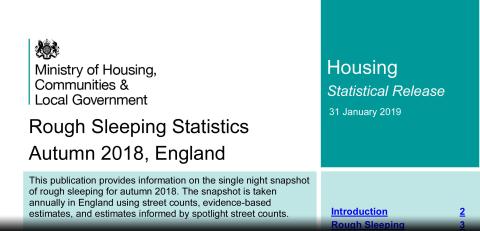When does sleeping rough not count as sleeping rough?

Rough Sleeping Statistics are produced annually by the Ministry of Housing, Communities and Local Government.
When does someone who is ‘sleeping rough’ not count as ‘sleeping rough’? This might seem a ridiculous question to ask – surely, it’s obvious, people who are sleeping rough (or street homeless, as it’s also called) count. However, this isn’t always the case, and who counts can have big implications for our understanding of the extent of ‘rough sleeping’, as well as the political claims and policy decisions that are made about ‘rough sleeping’.
Official definitions of rough sleeping in England define this as: “People sleeping, about to bed down (sitting on/in or standing next to their bedding) or actually bedded down in the open air (such as on the streets, in tents, doorways, parks, bus shelters or encampments). People in buildings or other places not designed for habitation (such as stairwells, barns, sheds, car parks, cars, derelict boats, stations, or “bashes” which are makeshift shelters, often comprised of cardboard boxes).”
To provide an estimate of the extent of rough sleeping in England, each local authority is asked to provide a count or estimate of the number of people sleeping rough in their area on a single night, providing a ‘snapshot’ figure. To aid this process, guidance is offered by the organisation Homeless Link on how local authorities should undertake counts or estimates. However, although this guidance exists, there is no guarantee that local authorities will adhere to this, and there is considerable discretion afforded to local authorities in how they arrive at their figures.
So local authorities can, to some extent, in their methods of counting and estimating, effectively decide who counts as sleeping rough and who does not. To give an idea of the impact of this level of discretion, one local authority, Northampton, provided an official count of 26 people sleeping rough for 2018. However, this figure excludes many people that the local authority know to be sleeping rough.
This was highlighted in a local BBC radio programme, in which a reporter stated that in a briefing before the very same count, the local authority’s ‘intelligence’ indicated there to be at least 46 people sleeping rough, but also claimed that 25 people were in camps which couldn’t be included in the figures due to safety issues. Yet, with such safety issues unspecified, it’s impossible to know whether another local authority might have included these people in their count. Indeed, the Homeless Link guidance itself suggests that “If you know that sleep sites are occupied but inaccessible or unsafe, consider using the estimate process (which can include a count) to achieve greater accuracy.” So it’s likely that another local authority might have done things differently. As such, it’s easy to see how discrepancies in the approach to who counts as sleeping rough can emerge.
Furthermore, because the official definition states that someone must be bedded down or about to bed down to be counted as sleeping rough, if they aren’t seen to be in either of these situations, then for the purposes of this these snapshot figures, they are unlikely to count as sleeping rough – even if there is ample evidence that they are doing so.
It should be said that issues with the methods of counting and estimating these figures are nothing new, and have been written about previously. But why does this matter now? In my view, there’s an enduring importance about recognising that behind each of these numbers is the life of another human being. However, these issues also take on a particular importance when rough sleeping statistics are produced and used as political tools.
The Westminster government recently released official statistics on the number of people estimated to be sleeping rough in England for 2018, based on these snapshot figures. This showed a 2% reduction in the number of people sleeping rough in 2018 compared with 2017, equating to 74 fewer people sleeping rough. It was the first time since 2010 that the official figure showed a reduction in the number of people sleeping rough. In media reports, this new figure was referred to as “a step in the right direction” by communities secretary, James Brokenshire.
But a reduction of 74 people is relatively a marginal change, and a few scenarios can help to give an idea of just how marginal a change this is. For example, if half of the local authorities in England estimated there to be just one more person sleeping rough, this would represent an increase in the number of people sleeping rough compared with the previous year, rather than a decrease. Or going back to the example of Northampton – if just four other local authorities had a similar discrepancy between the number of people they knew to be sleeping rough, and the number they reported, this would produce an overall rise across England too.
And such margins can make a big difference to the claims that can be made about policy. If this year’s figures had shown an eighth consecutive annual rise, rather than a fall, this almost certainly would put pressure on the Westminster government to do more (for example, by providing greater levels of funding for homelessness services and local authorities than have been offered thus far), rather than to suggest this was “a step in the right direction”.
So the question of when sleeping rough is not counted as sleeping rough is an important one, and is one that has significant implications for the political claims and policy decisions that are made about rough sleeping.
Daniel McCulloch, The Open University.
